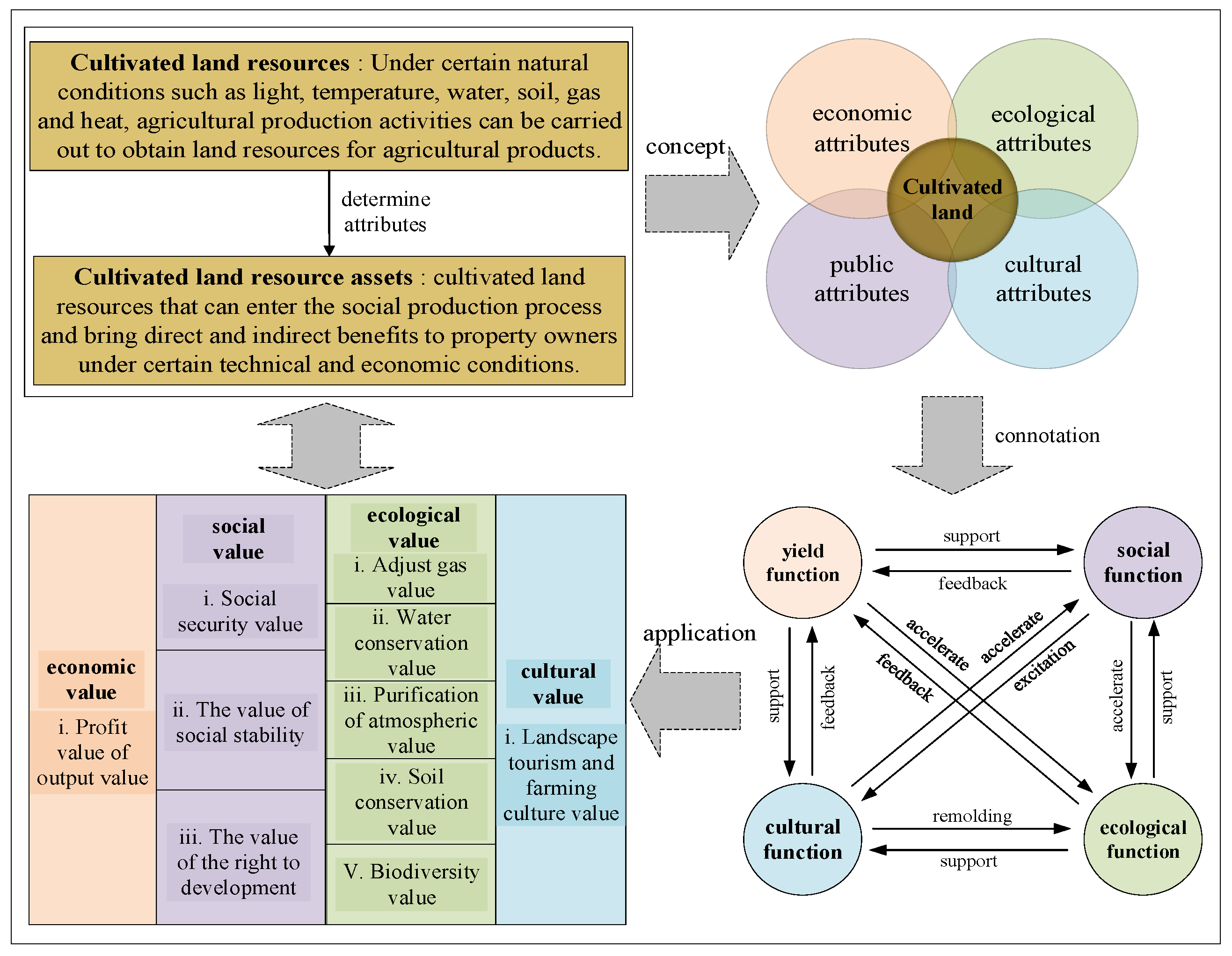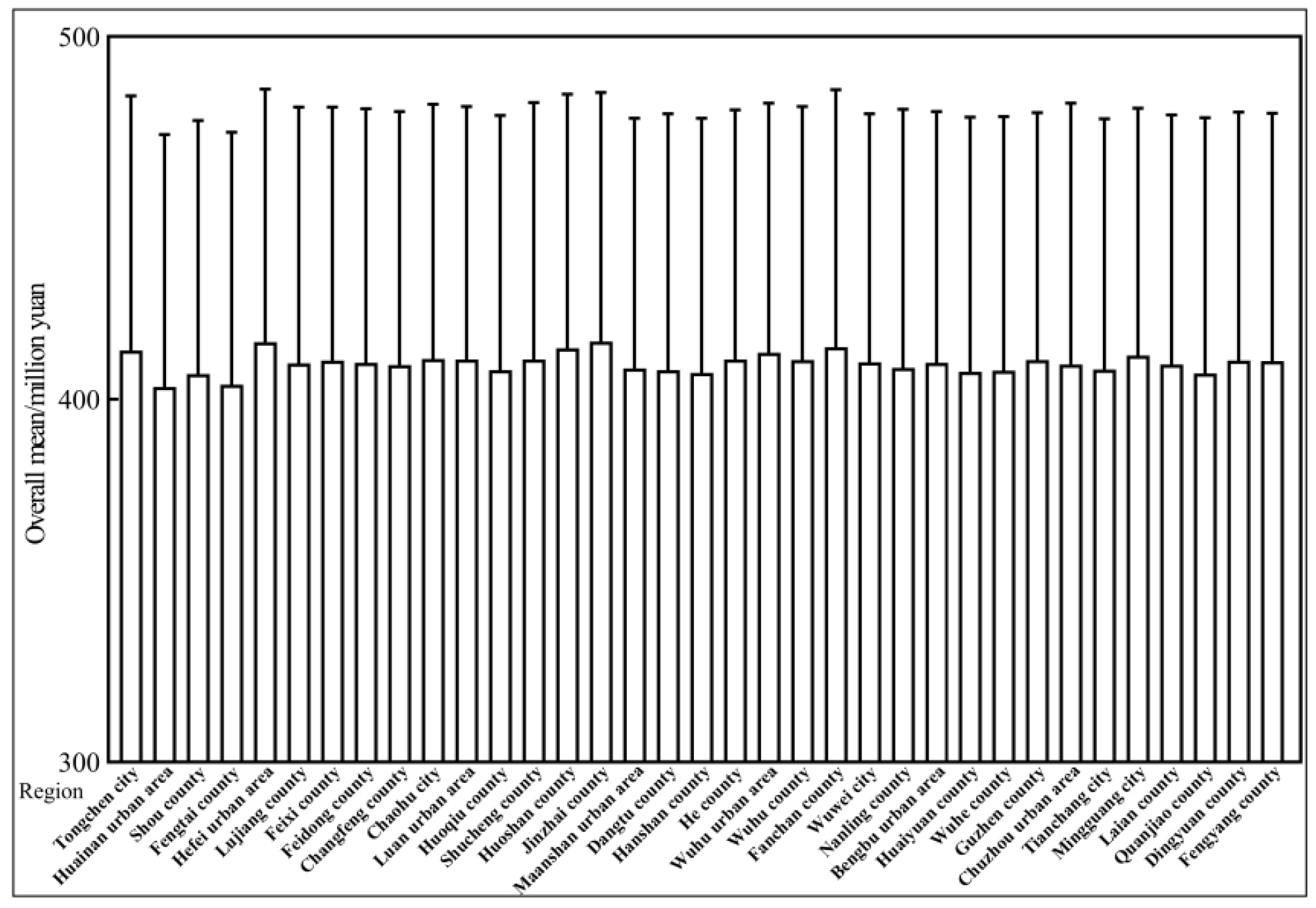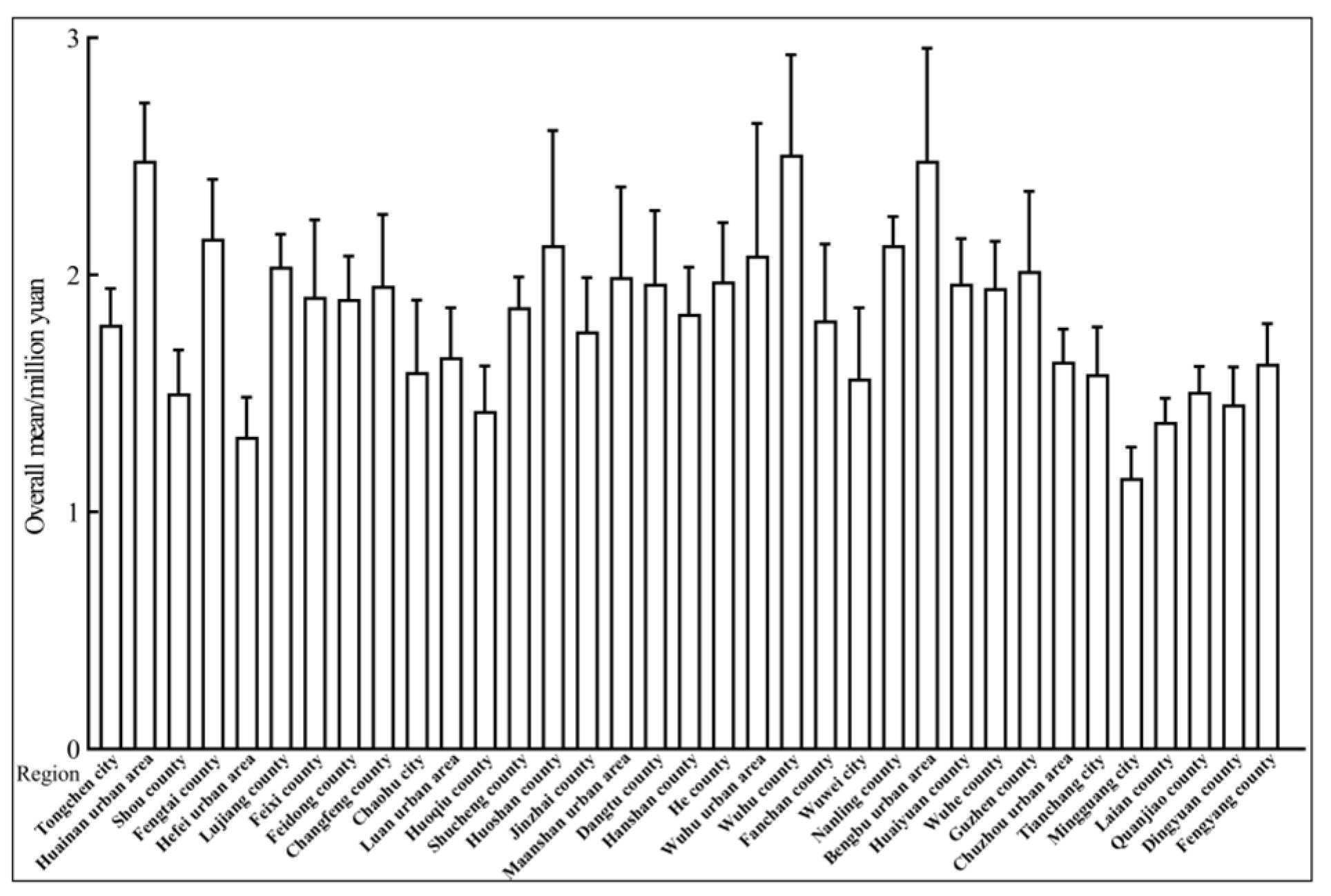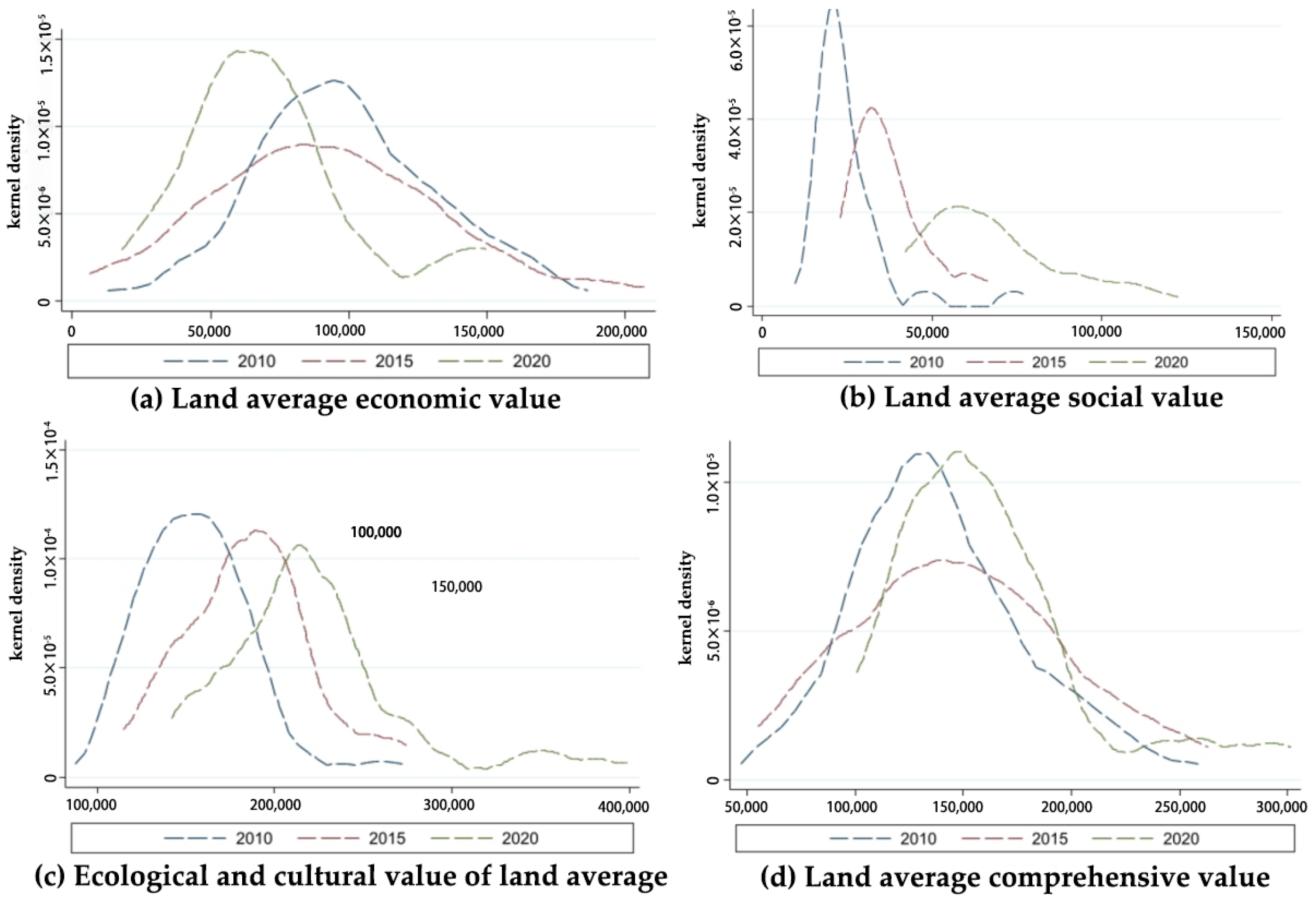Accounting for the Logic and Spatiotemporal Evolution of the Comprehensive Value of Cultivated Land around Big Cities: Empirical Evidence Based on 35 Counties in the Hefei Metropolitan Area
Abstract
:1. Introduction
2. Materials and Methods
2.1. Selection of Study Area
2.2. Data Sources
2.3. Research Methods
2.3.1. Analysis of Comprehensive Cultivated Land Value Accounting
Economic Values
- Value of Output Benefits
Social Values
- Life security values
- 2.
- Social stability values
- 3.
- Development rights values
Ecological Values
- Gas regulation values
- 2.
- Water containment Values
- 3.
- Purify atmospheric values
- 4.
- Soil conservation values
- 5.
- Maintaining biodiversity values
Cultural Values
2.3.2. Analysis of the Spatial and Temporal Evolution of the Comprehensive Value of Cultivated Land
Analysis of Dynamic Attitude
Analysis of Kernel Density
Analysis of Spatial Autocorrelation
- Global autocorrelation
- 2.
- Local autocorrelation
2.4. Accounting Logic of the Comprehensive Value of Cultivated Land
3. Results
3.1. Time Evolution Characteristics
3.2. Spatial Evolution Characteristics
3.2.1. Analysis of Dynamic Attitudes
3.2.2. Analysis of Kernel Density
3.2.3. Analysis of Spatial Autocorrelation
3.2.4. Analysis of Influencing Factors
- (1)
- The output value of grain production is a prerequisite for improving the economic value of cultivated land assets. Guzhen, Dingyuan, Wuwei, Shucheng, Lujiang, Fengyang counties, and other areas along the Yangtze and Huaihe rivers presented earlier agricultural development relative to the other areas. The government has supported policy, capital, science, and technology changes and vigorously promoted farmland construction. The quality of cultivated land has increased its output value. Therefore, the economic value of cultivated land resources increased earlier, while the agricultural development of the metropolitan area started slightly later. With decreased cultivated land, the overall trend declined.
- (2)
- Urbanisation is a crucial factor in changing the social value of cultivated land resource assets. Owing to the differences in the level of economic development in various regions of the Hefei metropolitan area, the level of urban economic development in this central region was relatively high, the population was large, and the level of new urbanisation was relatively high. Similarly, as cultivated land gradually decreased in the Hefei metropolitan area, the phenomenon of ‘non-agricultural’ and ‘non-grain’ development was common. Therefore, the minimum living security value and development rights value of cultivated land were relatively high in the metropolitan area, followed by those in areas along the Yangtze and Huaihe rivers and the Dabie Mountains.
- (3)
- Resource endowment and economic development were the primary causes of changes in the ecological and cultural values of cultivated land resource assets. The districts and counties along the Yangtze and Huaihe Rivers demonstrated superior natural conditions and high resource endowments in the Hefei metropolitan area. Owing to the constraints of natural and social conditions, the resource endowments of the districts and counties near northern Anhui were less than those along the Yangtze River.
4. Discussion
5. Conclusions and Deficiencies
- (1)
- As the measurement standards of the social, ecological, and cultural value have not yet been unified, a better accounting system for the multifunctional values of cultivated land should be established. Monetising the social, ecological, and cultural value of cultivated land to incorporate compensation standards for expropriation, including an increase in agricultural compensation and further improving the compensation mechanisms of the Hefei metropolitan area, could help to realize these multifunctional values. Moreover, the implementation of policies and measures for the protection of cultivated land, the construction of a green national economic accounting system, and the realisation of the coordinated development of the human–land relationship must be considered.
- (2)
- The comprehensive value of cultivated land in the Hefei metropolitan area showed a steady upward trend between 2010 and 2020, with a dynamic range of 57.03–61.44%. The social, ecological, and cultural values of cultivated land showed an increasing trend, while the economic value showed a decline. The economic value was high in the east and north and low in the west and south. This social value accounted for the highest proportion of the comprehensive value at approximately 87%, and it showed opposite spatial values that were relative to the economic value, which was low in the east and north and high in the west and south. The right to development value accounted for the largest proportion of social value (approximately 93%). Ecological and cultural values accounted for the smallest proportion of this comprehensive value, and the spatial distribution trend was similar to that of the economic value. The largest proportion of ecological and cultural values corresponded to the soil conservation value at approximately 67%.
- (3)
- The social value of cultivated land dominated the comprehensive value of cultivated land around big cities, and its value distribution was consistent with that of social and economic development. The social value of cultivated land showed that economically developed areas are hot spots in space, and the development rights and social security values of these areas were higher than those in other areas. The distribution of the economic value of cultivated land was highly consistent with the natural geographical conditions. Hotspots were located in the northeastern part of the study area in the Jianghuai Plain area. The soil conditions of the cultivated land were good and suitable for food crop production; thus, these areas produced high yields. The change in the ecological value of cultivated land was significantly affected by government policies and showed obvious upward trends in vital ecological protection areas along the Yangtze River (Wuhu urban area), Huaihe River (Bengbu urban area), and Dabie Mountain area (Huoshan County).
Author Contributions
Funding
Institutional Review Board Statement
Informed Consent Statement
Data Availability Statement
Conflicts of Interest
References
- Zhang, R.; Li, P.; Xu, L.; Zhong, S.; Wei, H. An integrated accounting system of quantity, quality and value for assessing cultivated land resource assets: A case study in Xinjiang, China. Glob. Ecol. Conserv. 2022, 36, e02104. [Google Scholar] [CrossRef]
- Jin, J.; He, R.; Wang, W.; Gong, H. Valuing cultivated land protection: A contingent valuation and choice experiment study in China. Land Use Policy 2018, 74, 214–219. [Google Scholar] [CrossRef]
- Gao, F.; Cui, J.; Zhang, S.; Xin, X.; Zhang, S.; Zhou, J.; Zhang, Y. Spatio-Temporal Distribution and Driving Factors of Ecosystem Service Value in a Fragile Hilly Area of North China. Land 2022, 11, 2242. [Google Scholar] [CrossRef]
- McMillen, D.; Singh, R. Land value estimation using teardowns. Hous. Econ. 2022, 58, 101874. [Google Scholar] [CrossRef]
- Öhlund, E.; Malmaeus, M.; Fauré, E. The significance of different realms of value for agricultural land in Sweden. Land Use Policy 2020, 96, 104714. [Google Scholar] [CrossRef]
- Chen, Y.; Wang, X.; Xie, Z. Land cover diversity: Reshaping the socioeconomic value of land. Environ. Manag. 2023, 332, 117404. [Google Scholar] [CrossRef]
- Hu, R.; Qiu, D.; Xie, D.; Wang, X.; Mo, Y. Asset accounting methods for arable land resources: A case of China. J. Southwest. Univ. 2013, 35, 127–132. [Google Scholar] [CrossRef]
- Qin, S.; Yin, H.; Xiong, Y. Evaluation of cultivated land resource value based on different value composition—Take Hunan province as an example. Resour. Environ. Yangtze Basin 2012, 21, 466–471. [Google Scholar]
- Wu, Z.; Ding, S.; Wei, C.; Gao, L. Estimation of social stability function value of cultivated land and its increments at plot scale in hill-mountain region. Res. Soil Water Conser. 2015, 22, 245–252. [Google Scholar] [CrossRef]
- Costanza, R. Valuing natural capital and ecosystem services toward the goals of efficiency, fairness, and sustainability. Ecosyst. Serv. 2020, 43, 101096. [Google Scholar] [CrossRef]
- Peng, J.; Zhao, Z.; Yin, G. Evaluation of urban land resource value based on sustainable environment space governance. Alex. Eng. J. 2022, 61, 5585–5593. [Google Scholar] [CrossRef]
- Craig, L.A.; Palmquist, R.B.; Weiss, T. Transportation Improvements and Land Values in the Antebellum United States: A Hedonic Approach. J. Real Estate Finance Econ. 1998, 16, 173–189. [Google Scholar] [CrossRef]
- Yaagoubi, R.; Faisal, K.; Miky, Y. Land value assessment based on an integrated Voronoi-geographically weighted regression approach in Makkah, Saudi Arabia. J. King Saud Univ.-Sci. 2021, 33, 101557. [Google Scholar] [CrossRef]
- Vitaliano, D.F.; Hill, C. Agricultural districts and farmland prices. J. Real Estate Finance Econ. 1994, 8, 213–223. [Google Scholar] [CrossRef]
- Awasthi, M. Socioeconomic determinants of farmland value in India. Land Use Policy 2014, 39, 78–83. [Google Scholar] [CrossRef]
- Li, M.; Li, L.; Yin, S. Estimation of Farmland Resources’ Value Loss in Process of Farmland Expropriation—Taking Hunan Province as an Example. Econ. Geogr. 2015, 35, 184–188. [Google Scholar] [CrossRef]
- Sandhu, H.S.; Wratten, S.D.; Cullen, R.; Case, B. The future of farming: The value of ecosystem services in conventional and organic arable land, An experimental approach. Ecol. Econ. 2008, 64, 835–848. [Google Scholar] [CrossRef]
- Wang, Y.; Li, X.; He, H.; Xin, L.; Tan, M. How reliable are cultivated land assets as social security for Chinese farmers? Land Use Policy 2020, 90, 104318. [Google Scholar] [CrossRef]
- Huang, X. A study on the technical procedure and methods for evaluating arable land—A case studying evaluation of cultivated land in Nanjing. J. Nanjing Agric. Univ. 1997, 20, 104–108. [Google Scholar]
- Zhu, C.; Li, W.; Du, Y.; Xu, H.; Wang, K. Spatial and temporal variation in the multifunctional value of cropland and trade-off-synergy relationships in Zhejiang Province. Trans. Chin. Soc. Agric. Eng. 2020, 36, 263–272. [Google Scholar]
- Huang, X. Study on the accounting value of cultivated land resources in Jiangsu Province. Jiangsu Soc. Sci. 1999, 4, 55–60. [Google Scholar]
- Cai, Y.; Huo, Y. Reevaluating Cultivated Land in China: Method and Case Studies. Acta Geogr. Sin. 2006, 10, 1084–1092. [Google Scholar]
- Xie, L.; Bai, Z.; Yang, B.; Du, X.; Yang, K.; Fu, S. Resources evaluation and spatial pattern analysis of the cultivated land in Xiangyuan County. J. China Agric. Univ. 2022, 27, 204–214. [Google Scholar]
- Zhu, D.; Du, T. Accounting Method and Result Analysis of Cultivated Land Resource Asset in China. China Land Sci. 2017, 31, 23–31+2+97. [Google Scholar]
- Wang, X.; Hu, S.; Tong, L. The value and spatial distribution of cultivated land resources in Tuanfeng County. Resour Sci. 2016, 38, 206–216. [Google Scholar]
- Ye, S.; Li, S. Study on the Social Value of Cultivated Land Resources in Xi’an Based on CVM. Chin. J. Agric. Resour. Reg. Plan. 2013, 34, 27–32. [Google Scholar]
- Zhang, H.; Jin, Y.; Wang, B.; Feng, S.; Qu, F. Compensation for cultivated land protection of Shanxi province based on the calculation of cultivated land development rights. Trans. Chin. Soc. Agric. Eng. 2018, 34, 256–266. [Google Scholar] [CrossRef]
- Xie, G.; Xiao, Y.; Zhen, L.; Lu, C. Study on ecosystem services value of food production in China. Chin. J. Eco-Agric. 2005, 13, 10–13. [Google Scholar]
- Wu, Y.; Huang, Z.; Han, D.; Qiu, X.; Pan, Y. Evolution of Urban Ecosystem Service Value and a Scenario Analysis Based on Land Utilization Changes: A Case Study of Hangzhou, China. Sustainability 2023, 15, 8274. [Google Scholar] [CrossRef]
- Su, H.; Wu, C. Analysis of the Influencing Factors of the Cultivated Land Resources Value in Black Soil Region Based on the Production-Living-Ecological Functions: A Case Study in Keshan County, Heilongjiang Province. China Land Sci. 2020, 34, 77–85. [Google Scholar] [CrossRef]
- Xie, G.; Zhang, C.; Zhang, L.; Chen, W.H.; Li, S.M. Improvement of the Evaluation Method for Ecosystem Service Value Based on Per Unit Area. J. Nat. Resour. 2015, 30, 1243–1254. [Google Scholar]
- Zhong, X.; Li, H. Exploration of the accounting path of cultivated land resource value in China. China Land. 2021, 2, 41–43. [Google Scholar] [CrossRef]
- Lautrup, M.; Panduro, T.E.; Olsen, J.V.; Pedersen, M.F.; Jacobsen, J.B. Is there more to trees than timber? Estimating the private amenity value of forests using a hedonic land model for combined agricultural properties. For. Policy Econ. 2023, 146, 102867. [Google Scholar] [CrossRef]
- Carolyn, N.M.; DeLoyde, W.E.; Mabee. Ecosystem service values as an ecological indicator for land management decisions: A case study in southern Ontario, Canada. Ecol. Indic. 2023, 151, 110344. [Google Scholar]
- Fikrey, T.; Solomon, A.T.; Yitea, S.G.; Estifanos, L.; Abrha, Y.G. Evaluating the impact of land use land cover changes on the values of ecosystem services in the Chacha Watershed, Ethiopia’s central highland. Environ. Sustain. Indic. 2023, 18, 100256. [Google Scholar] [CrossRef]
- Tang, X.; Pan, Y.; Liu, Y. Assessment of ecological value and spatial and temporal change of cultivated land in Beijing. Chin. J. Agric. Resour. Reg. Plan. 2018, 39, 132–140. [Google Scholar]
- Shang, Q.; Song, G.; Xiang, C. Estimation of Cultivated Land Value of Bayan County, Heilongjiang Province. Res. Soil Water Conserv. 2012, 19, 231–236. [Google Scholar]
- King, R.; Burton, S. Land ownership values and rural structural change in Cyprus. J. Rural Stud. 1989, 5, 267–277. [Google Scholar] [CrossRef]
- Costanza, R.; D’Arge, R.; DeGroot, R.; Farber, S.; Grasso, M.; Hannon, B.; Limburg, K.; Naeem, S.; O’Neill, R.V.; Paruelo, J.; et al. The value of the world’s ecosystem services and natural capital. Nature 1997, 387, 253–260. [Google Scholar] [CrossRef]
- Wang, S.; Tan, R.; Wu, L. Assessing the amenity value of agricultural land: A case study in Jiangsu Province. Resour. Environ. Yangtze Basin 2005, 06, 48–52. [Google Scholar]
- Wang, W.; Huang, X. Regional division and evaluation on arable land value in mainland China. Resour. Sci. 1997, 04, 3–10. [Google Scholar]
- Clauretie, T.M.; Li, H. Land Values: Size Matters. J. Real Estate Finance Econ. 2019, 58, 80–110. [Google Scholar] [CrossRef]
- Barr, J.; Smith, F.H.; Kulkarni, S. What’s Manhattan worth? A land values index from 1950 to 2014. Reg. Sci. Urban Econ. 2018, 70, 1–19. [Google Scholar] [CrossRef]
- McDonald, J.; McMillen, D. Land Values, Land Use, and the First Chicago Zoning Ordinance. J. Real Estate Finance Econ. 1998, 16, 135–150. [Google Scholar] [CrossRef]
- Wang, F.; Fu, W.; Chen, J. Spatial–Temporal Evolution of Ecosystem Service Value in Yunnan Based on Land Use. Land 2022, 11, 2217. [Google Scholar] [CrossRef]
- Han, J.; Hu, Z.; Wang, P.; Yan, Z.; Li, G.; Zhang, Y.; Zhou, T. Spatio-temporal evolution and optimization analysis of ecosystem service value—A case study of coal resource-based city group in Shandong, China. J. Clean. Prod. 2022, 363, 132602. [Google Scholar] [CrossRef]
- Xin, X.; Zhang, T.; He, F.; Zhang, W.; Chen, K. Assessing and simulating changes in ecosystem service value based on land use/cover change in coastal cities: A case study of Shanghai, China. Ocean Coast. Manag. 2023, 39, 106591. [Google Scholar] [CrossRef]
- Dashtbozorgi, F.; Hedayatiaghmashhadi, A.; Dashtbozorgi, A.; Ruiz-Agudelo, C.A.; Fürst, C.; Cirella, G.T.; Naderi, M. Ecosystem services valuation using InVEST modeling: Case from southern Iranian mangrove forests. Reg. Stud. Mar. Sci. 2023, 60, 102813. [Google Scholar] [CrossRef]
- Pu, L.; Huang, X.; Zhou, F. Study on the arable land protection in developed regions—A case study in the Yangtze River Delta. Econ. Geogr. 2002, S1, 76–78. [Google Scholar]













| Author | Scale of Study | Theory or Method | Research Content |
|---|---|---|---|
| Huang, X. et al. (1997) [19] | China | Agricultural area correction coefficient method. | The average unit price of cultivated land resources and the asset prices of 30 agricultural regions in 1993 were calculated. |
| Hu, R. et al. (2013) [7] | China | Income reduction method. | Based on estimating the net income of cultivated land in China, the total amount of cultivated land resources in 1998 and 2008 was calculated. |
| Chen, H. (2003) [6] | Provincial | Income multiple methods. | The economic value of cultivated land resources in Shandong Province was calculated using fuzzy mathematics and the grey system theory. |
| Cai, Z. (2009) [24] | Watershed | Market value method. Opportunity cost method et al. | Comprehensive value accounting for cultivated land resources in the Huang-Huai-Hai region. |
| Li, J. et al. (2010) [7] | Provincial | Income reduction method. Equivalent factor method et al. | The economic, social, and ecological values of cultivated land resources in Shanxi Province in 2007 were estimated, and these solutions were put forward. |
| Qin, S. et al. (2012) [8] | Provincial | Income approach. | Based on survey data on the net income of agricultural products, the economic value of cultivated land resources in Hunan Province was calculated. |
| Wu, Z. et al. (2013) [9] | Land mass | Income reduction method. Shadow price method et al. | The social security function value of cultivated land in hilly and mountainous areas was measured at the plot scale, and the influence mechanism of the social security value was identified. |
| Zhu, D. et al. (2017) [24] | Provincial | Agricultural land valuation theory. | Based on the data of cultivated land transfer rent and the national survey data, the economic value of cultivated land in 2016 was calculated. |
| Li, J. et al.(2009) [24] | City | Market value method. Results reference method et al. | Based on the statistical data of 2002, the total economic, social, and ecological value of cultivated land resources in Qingdao was calculated. |
| Wang, X. et al. (2016) [25] | County | The alternative market approaches. Social development coefficient correction method et al. | The economic, social, and ecological comprehensive values of cultivated land resources in Tuanfeng County in 2013 were calculated, and their spatial distribution characteristics were analysed. |
| Xie, L.et al. (2022) [23] | County | Income reduction method. Equivalent factor method et al. | The comprehensive value of cultivated land resources in Xiangyuan County in 2017 was calculated, and its spatial distribution was analysed. |
| Zhong, X. (2021) [32] | Grid | Income reduction method. Carbon tax law. Production cost method et al. | Based on the theory of production capacity, the economic and ecological value of cultivated land resources in Jiangxi Province in 1980 and 2010 was calculated, and its spatial distribution pattern was analysed. |
| Daniel McMillen; Ruchi Singh (2022) [4] | City, County | Similar to the Stein method and non-teardown sales. | Used data from Chicago and Maricopa County demonstrated the ability of these two approaches to estimate land value. |
| Lautrup. et al. (2023) [32] | Island | Pleasant value model. | Took the Danish peninsula of Jutland as a case through the land-value model estimate of landowners’ private amenity value of forests; the value of an additional hectare of forest was predicted using the hedonic model and compared with the forest’s expectation value based on accounting statistics for forest income. |
| Carolyn N. M. DeLoyde, W. E. Mabee (2023) [34] | Provincial | Ecological service value. | This research quantified the economic value of ecosystem services by land cover type, using a case study approach and data localized to southern Ontario, Canada. |
| Fikrey Tesfay. et al. (2023) [35] | Watershed | The maximum likelihood classifier. | This paper used Chacha Watershed as a case to assess the impact of LULC changes on the value of ecosystem services for the sensitivity of display ecosystem services. |
Disclaimer/Publisher’s Note: The statements, opinions and data contained in all publications are solely those of the individual author(s) and contributor(s) and not of MDPI and/or the editor(s). MDPI and/or the editor(s) disclaim responsibility for any injury to people or property resulting from any ideas, methods, instructions or products referred to in the content. |
© 2023 by the authors. Licensee MDPI, Basel, Switzerland. This article is an open access article distributed under the terms and conditions of the Creative Commons Attribution (CC BY) license (https://creativecommons.org/licenses/by/4.0/).
Share and Cite
Wang, B.; Chen, T.; Liu, W. Accounting for the Logic and Spatiotemporal Evolution of the Comprehensive Value of Cultivated Land around Big Cities: Empirical Evidence Based on 35 Counties in the Hefei Metropolitan Area. Sustainability 2023, 15, 11048. https://doi.org/10.3390/su151411048
Wang B, Chen T, Liu W. Accounting for the Logic and Spatiotemporal Evolution of the Comprehensive Value of Cultivated Land around Big Cities: Empirical Evidence Based on 35 Counties in the Hefei Metropolitan Area. Sustainability. 2023; 15(14):11048. https://doi.org/10.3390/su151411048
Chicago/Turabian StyleWang, Bingyi, Tong Chen, and Wangbing Liu. 2023. "Accounting for the Logic and Spatiotemporal Evolution of the Comprehensive Value of Cultivated Land around Big Cities: Empirical Evidence Based on 35 Counties in the Hefei Metropolitan Area" Sustainability 15, no. 14: 11048. https://doi.org/10.3390/su151411048
APA StyleWang, B., Chen, T., & Liu, W. (2023). Accounting for the Logic and Spatiotemporal Evolution of the Comprehensive Value of Cultivated Land around Big Cities: Empirical Evidence Based on 35 Counties in the Hefei Metropolitan Area. Sustainability, 15(14), 11048. https://doi.org/10.3390/su151411048





